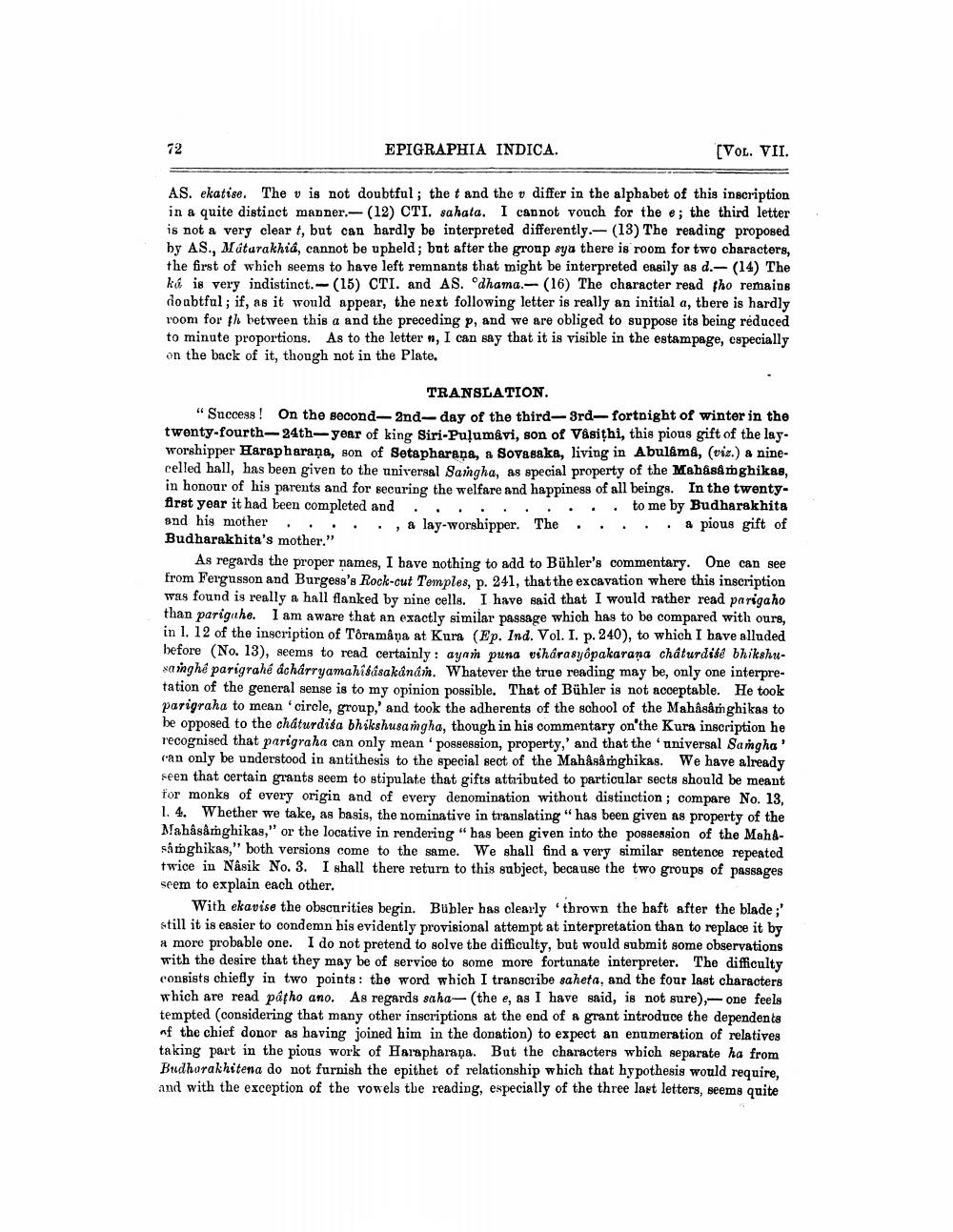________________
EPIGRAPHIA INDICA.
(VOL. VII.
AS. ekatise. The v is not doubtful; the t and the v differ in the alphabet of this inscription in a quite distinct manner.-- (12) OTI, sahata. I cannot vouch for the e; the third letter is not a very clear t, but can hardly be interpreted differently.- (13) The reading proposed by AS., Matarakhid, cannot be upheld; but after the group sya there is room for two characters, the first of which seems to have left remnants that might be interpreted easily as d.- (14) The ki is very indistinct. (15) CTI. and AS. °dhama.-- (16) The character read tho remains doubtful; if, as it would appear, the next following letter is really an initial a, there is hardly room for th between this a and the preceding p, and we are obliged to suppose its being reduced to minute proportions. As to the letter *, I can say that it is visible in the estampage, especially on the back of it, though not in the Plate.
TRANSLATION "Success! On the second-and-day of the third-3rd-fortnight of winter in the twenty-fourth-24th-year of king Siri-Pulumâvi, son of Vasithi, this pious gift of the lay. worshipper Harapharaņa, son of Setapharana, a Sovasaka, living in Abulama, (viz.) a ninecelled hall, has been given to the universal Saigha, as special property of the Mahasimghikas, in honour of his parents and for securing the welfare and happiness of all beings. In the twentyfirst year it had been completed and . . . . . . . . . to me by Budharakaita and his mother . . . . . , lay-worshipper. The . . . . . a pious gift of Budharakhita's mother."
As regards the proper names, I have nothing to add to Bühler's commentary. One can see from Fergusson and Burgess's Rock-out Temples, p. 241, that the excavation where this inscription was found is really a hall flanked by nine cells. I have said that I would rather read parigaho than pariguhe. I am aware that an exactly similar passage which has to be compared with ours, in l. 12 of the inscription of Tôramâna at Kura (Ep. Ind. Vol. I. p. 240), to which I have alluded before (No. 13), seems to read certainly : ayam puna vihárasyöpakarana chaturdise bhikshusa inghé parigrahé dchárryamahi ásakanan. Whatever the true reading may be, only one interpretation of the general sense is to my opinion possible. That of Bühler is not acceptable. He took parigraha to mean "circle, group,' and took the adherents of the school of the Mahâsârghikas to be opposed to the cháturdisa bhikshusangha, though in his commentary on the Kura inscription he recognised that parigraha can only mean possession, property,' and that the universal Samgha' (an only be understood in antithesis to the special sect of the Mah&samghikas. We have already seen that certain grants seem to stipulate that gifts attributed to particular sects should be meant for monks of every origin and of every denomination without distinction; compare No. 13, 1. 4. Whether we take, as basis, the nominative in translating " has been given as property of the Mahasanghikas," or the locative in rendering " has been given into the possession of the Mahdså toghikas," both versions come to the same. We shall find a very similar sentence repeated twice in Nâsik No. 3. I shall there return to this subject, because the two groups of passages seem to explain each other.
With ekavise the obscurities begin. Bubler has clearly thrown the haft after the blade;' still it is easier to condemn bis evidently provisional attempt at interpretation than to replace it by a more probable one. I do not pretend to solve the difficulty, but would submit some observations with the desire that they may be of service to some more fortunate interpreter. The difficulty consists chiefly in two points: the word which I transcribe saheta, and the four last characters which are read patho ano. As regards saha-(the e, as I have said, is not sure),- one feels tempted (considering that many other inscriptions at the end of a grant introduce the dependents of the chief donor as having joined him in the donation) to expect an enumeration of relatives taking part in the pious work of Harapharana. But the characters which separate ha from Budhorakhitena do not furnish the epithet of relationship which that hypothesis would require, and with the exception of the vowels the reading, especially of the three lart letters, seems quite




